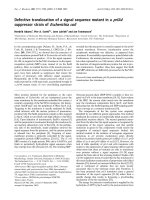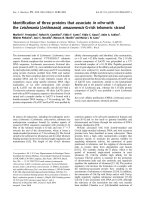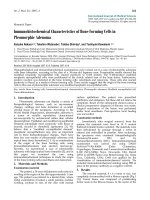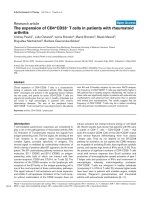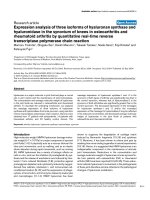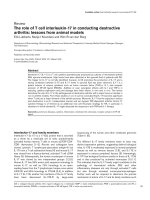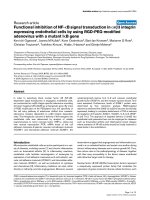Báo cáo y học: "Mechanical characteristics of three staples commonly used in foot surgery" pps
Bạn đang xem bản rút gọn của tài liệu. Xem và tải ngay bản đầy đủ của tài liệu tại đây (408.3 KB, 5 trang )
BioMed Central
Page 1 of 5
(page number not for citation purposes)
Journal of Foot and Ankle Research
Open Access
Research
Mechanical characteristics of three staples commonly used in foot
surgery
Ulfin Rethnam*
1
, Jan Kuiper
2
and Nilesh Makwana
3
Address:
1
Department of Orthopaedics, Glan Clwyd Hospital, Bodelwyddan, UK,
2
Hip Research Unit, Robert Jones & Agnes Hunt Orthopaedic
Hospital, Oswestry, UK and
3
Department of Orthopaedics, Robert Jones & Agnes Hunt Orthopaedic Hospital, Oswestry, UK
Email: Ulfin Rethnam* - ; Jan Kuiper - ; Nilesh Makwana -
* Corresponding author
Abstract
Background: Bone staples are an accepted method of fixation in foot surgery. They reduce
operating time and trauma in surgical procedures. A variety of memory staples are available but
their properties compared to standard staples are not known. We carried out a study comparing
two popular types of memory staples and a standard stainless steel staple.
Methods: Standardized bone models of metatarsals made from Tufnol tubes were osteotomized
and stabilised using one of three types of bone staples, two types of memory staple (Memory staple
and heat-activated Memoclip) or a standard stainless steel staple (Richards). Constructs were
loaded in bending and torsion on a material testing machine. The moment and torque to achieve
10 degree of bending or torsion and permanent angulation of the osteotomized bones were
assessed.
Results: The Richards staple was found to provide a four times larger resistance to bending and
torsion than the two memory staples. However, it was permanently deformed after bending. The
Memory and Memoclip staples were equal in their stiffness. In addition, angulation of bones fixed
with the Memoclip was elastic, preventing any permanent deformation.
Conclusion: The Richards staple was stiffer, although the permanent deformation of this staple is
a disadvantage. Memoclip staples exhibit lower but adequate stiffnesss when compared to the
standard Richards staple and are not permanently deformed after bending. The Memoclip staples
were easier to handle. The results will enable surgeons to determine the optimal staple for foot
and ankle procedures.
Background
Bone staples are widely used in foot and ankle surgery.
They are considered to be an effective internal fixation
method [1]. The cited advantages of bone staples include
easier fixation onto bones, reduced surgical time and
trauma. This in turn leads to improved healing and
reduced post-operative pain [2].
Various types of bone staples are available, differing in
their shape and physical properties. Recently, bone staples
have been introduced based on shape-memory materials.
For all staples, manufacturers cite advantages in terms of
ease of use and provide compression strength based on
physical properties of the metals used to produce the sta-
ples. However, little is known about the actual fixation
Published: 25 February 2009
Journal of Foot and Ankle Research 2009, 2:5 doi:10.1186/1757-1146-2-5
Received: 22 August 2008
Accepted: 25 February 2009
This article is available from: />© 2009 Rethnam et al; licensee BioMed Central Ltd.
This is an Open Access article distributed under the terms of the Creative Commons Attribution License ( />),
which permits unrestricted use, distribution, and reproduction in any medium, provided the original work is properly cited.
Journal of Foot and Ankle Research 2009, 2:5 />Page 2 of 5
(page number not for citation purposes)
capabilities of staples used in foot and ankle surgery and
how these compare between staples. It is unknown how
the fixation capabilities of staples based on memory mate-
rial compare to those of conventional metals.
The aim of this study was to compare two types of staples
based on memory metal and one conventional staple, all
three commonly used in foot and ankle surgery. Specifi-
cally, we addressed the question regarding the bending
stiffness, torsional stiffness, and permanent deformation
of these staples. The null hypothesis was that there was no
difference in stiffness between the staples.
Methods
This study was conducted in the Laboratory for Biome-
chanics at The Robert Jones and Agnes Hunt Orthopaedic
Hospital in Oswestry after approval from the review
board.
Materials
Three types of staples were used in this study, two of
which were made of nickel-titanium (nitinol) memory
material. All the staples had a bridge dimension of 14 mm
and leg dimensions of 12 mm. The first of these, Memo-
clip (Heritage, United Kingdom), is heat activated (Figure
1). When the staple is exposed to a temperature above 50
degrees Centigrade, these staples deform their limbs and
generate compression. The second of these, the Memory
staple (Depuy, United Kingdom), is normally stored at 0
– 4 degrees Centigrade. When the staple is brought to
body temperature (37 degrees Centigrade), the limbs
deform and cause compression of bone. The third staple
(Richards staple, Smith & Nephew, United Kingdom) is
made of stainless steel (Figure 1). Compression is
achieved by the mechanical properties of the staple. No
further compression is achieved once the staple is inserted
into bone.
Specimen preparation
Standardised metatarsal bone models made of Tufnol
tubes (10 mm diameter) were used (Figure 2). We used
Tufnol tubes for our study as they exhibit similar proper-
ties to bone and are commonly used in biomechanical
studies [3,4].
The Tufnol tubes were 15 cm in length and they were oste-
otomised in the centre with a saw. The osteotomised tubes
were stabilised using a single staple applied perpendicular
to the osteotomy. Fixation of the near and far cortices
(bicortical) was done for each specimen. 5 specimens
were constructed for each staple type (n = 5 for each staple
type).
Mechanical testing
The prepared specimens were mounted on a materials
testing machine (ESH Ltd, Brierly Hills, United Kingdom)
(Figure 3). Each construct was tested in four point bend-
ing and torsional stress (Figure 4). Load displacement
curve and stiffness of fixation of each staple were meas-
ured. A constant temperature of 37 degrees Centigrade
was maintained throughout the experiment using a ther-
mostat controlled fan heater.
Outcome measures and statistical analysis
The primary outcome measure was the moment to
achieve 10 degree of bending or torsion at the osteotomy
site of the specimen. A 10 degree deformation of the con-
struct was considered as mechanical failure of the staple as
in a clinical situation 10 degree angulation at a fracture or
osteotomy after fixation would be considered as an
implant failure (Figure 5).
One-way Analysis of Variance (ANOVA) was used for sta-
tistical analysis of the results and the Tukey test was used
for pairwise comparison between the staples. p < 0.05 was
considered to be statistically significant.
Memory (left) & mechanical (right) staplesFigure 1
Memory (left) & mechanical (right) staples.
Tufnol tubes usedFigure 2
Tufnol tubes used.
Journal of Foot and Ankle Research 2009, 2:5 />Page 3 of 5
(page number not for citation purposes)
Results
Bending stress
In four point bending, there was a non-linear relation
between the bending angle and the bending moment. The
average moment to achieve 10 degree of bend at the oste-
otomy site of the specimens was as follows: Richards sta-
ple: 1.9 ± 0.21 Nm, Memoclip staple: 0.51 ± 0.1 Nm and
Memory staple: 0.44 ± 0.03 Nm. The Richards staple was
four times stiffer than the Memory and Memoclip staples.
This difference was statistically significant (p < 0.01,
ANOVA followed by Tukey pairwise test) (Figure 6, 7).
There was no significant difference between the Memoclip
and Memory staple (p = 0.26, ANOVA followed by Tukey
pairwise test). On removal of the load, constructs fixed
with the Memoclip staple returned to their original shape
while the other two staples were permanently deformed
(Figure 6).
Torsional stress
In torsion, there was a linear relation between the torsion
angle and applied torque. The average moment to achieve
10 degree torsion of the construct was as follows: Richards
staple: 0.12 ± 0.03 Nm/degree, Memoclip staple: 0.04 ±
0.01 Nm/degree and Memory staple: 0.03 ± 0.01 Nm/
degree.
The Richards staple was four times stiffer than the Mem-
ory and Memoclip staples. This difference was statistically
significant (p < 0.01, ANOVA followed by Tukey pairwise
test) (Figure 8). There was no significant difference in tor-
sional stiffness between the Memoclip and the Memory
staple (p = 0.998, ANOVA followed by Tukey pairwise
Materials testing machineFigure 3
Materials testing machine.
Specimen undergoing four point bending stressFigure 4
Specimen undergoing four point bending stress.
Deformation of construct on four point bending stressFigure 5
Deformation of construct on four point bending
stress.
Load displacement curves for different staples in bendingFigure 6
Load displacement curves for different staples in
bending.
EHQGLQJDQJOHGHJUHHV
EHQGLQJPRPHQW1P
5LFKDUGV
0HPRU\VWDSOH
0HPRFOLS
Journal of Foot and Ankle Research 2009, 2:5 />Page 4 of 5
(page number not for citation purposes)
test). Upon removal of the load, all constructs returned to
their original shape suggesting that there was no perma-
nent deformation of the staples.
Discussion
Bone staples are used commonly in foot and ankle sur-
gery. No data exists in the literature on the comparative
analysis of biomechanical properties of bone staples. The
fixation stiffness in bone staples is one of the most impor-
tant factors determining the success of osteosynthesis
along with compression achieved at the osteotomy site.
There are studies evaluating the mechanical properties
using different staple configuration and leg lengths of sta-
ples [5]. There are no studies that compare mechanical
properties of staples with different physical properties.
The staples selected for the study were made of different
materials and had different physical properties. Two sta-
ples (Memoclip and Depuy Memory staple) achieved
compression following deformation of the limbs when
exposed to a particular temperature. The other staple
(Richards) achieved compression by mechanically hold-
ing the bone ends across the osteotomy site. With bicorti-
cal fixation, the constructs fixed with the Richards staple
was the stiffest in both bending and torsion stress. There
was a permanent deformation of the Richard staple on
bending and this may be a disadvantage of this staple as
deformation of this manner in a clinical scenario would
cause distraction at the osteotomy site.
Both temperature activated memory staples (Memoclip
and Memory staple) had similar fixation stiffness in bend-
ing & torsion. The Memoclip staple resisted permanent
deformation while the Memory staple revealed some per-
manent deformation on bending. The advantages of these
staples are that they cause compression at the osteotomy
site after insertion. The mechanically activated Richards
staple will also apply compression after insertion; it will
not however have a propensity to deform further as will
the shape-memory staples. Comparing the two memory
staples, the Memoclip staples were easy to use as deforma-
tion of the limbs occurred only when exposed to temper-
atures >50 degree Centigrade. The Memory staple showed
deformation of the limbs when exposed to body temper-
ature therefore making insertion more difficult.
The strength of our study was that it was conducted in a
uniform environment maintaining constant temperature
and a substitute (Tufnol tubes) similar to bone was used.
The results of our study show that permanent deforma-
tion of the Richards staple occurs with increasing bending
and torsional stress. However the Richards staple was on
an average four fold stiffer than the temperature depend-
ent staples. There was no significant difference between
the Memoclip and Memory staples with regards to stiff-
ness although the Memory staple did undergo permanent
deformation in bending. This study will allow surgeons to
make a more informed choice when using staples in foot
and ankle surgery. Further clinical trials would be needed
to compare these staples with regards to bone healing and
fatigue failure.
Conclusion
Biomechanical testing of three different staples used in
foot and ankle surgery revealed the Richards staple to have
the highest fixation stiffness in both bending and torsion,
although there was permanent deformation. The Memo-
clip staples provided adequate stiffness, resisted perma-
nent deformation and were easier to handle which could
be its advantages when compared to the Richards and
Memory staple.
Competing interests
The authors declare that they have no competing interests.
Authors' contributions
UR the main author for the manuscript and was involved
in specimen preparation, conducting the study, data
acquisition and preparation of the manuscript. JK was
involved in setting up of equipment, data analysis, inter-
Bending stiffness for different staplesFigure 7
Bending stiffness for different staples.
5LFKDUGV 0HPRU\VWDSOH 0HPRFOLS
PRPHQWWREHQGGHJUHHV
Torsion stiffness for different staplesFigure 8
Torsion stiffness for different staples.
5LFKDUGV 0HPRU\VWDSOH 0HPRFOLS
WRUVLRQDOVWLIIQHVV1PGHJ
Publish with Bio Med Central and every
scientist can read your work free of charge
"BioMed Central will be the most significant development for
disseminating the results of biomedical research in our lifetime."
Sir Paul Nurse, Cancer Research UK
Your research papers will be:
available free of charge to the entire biomedical community
peer reviewed and published immediately upon acceptance
cited in PubMed and archived on PubMed Central
yours — you keep the copyright
Submit your manuscript here:
/>BioMedcentral
Journal of Foot and Ankle Research 2009, 2:5 />Page 5 of 5
(page number not for citation purposes)
pretation of data and preparation of the manuscript. NM
the senior author was involved in conception and design
of the study. All authors have read and approved the final
manuscript.
About the Authors
UR - Orthopaedic registrar. JK - Research scientist. NM -
Consultant Trauma & Orthopaedics
References
1. Mow EM, Darby HD: Powered metaphyseal stapler: an effec-
tive and simplified internal fixation system used in multiple
types of podiatric surgery. J Foot Surg 1991, 30(6):558-63.
2. Weltmer JB Jr, Cracchiolo A 3rd: The use of the powered meta-
physeal stapler for reconstructive procedures in the adult
foot. Foot Ankle 1990, 11(1):12-5.
3. Humphreys PK, Orr JF, Bahrani AS: An investigation into the
effect of cyclic loading and frequency on the temperature of
PMMA bone cement in hip prostheses. Proc Inst Mech Eng [H]
1989, 203(3):167-70.
4. Moorcroft CI, Thomas PB, Verborg S, Ogrodnik PJ: Cortex distrac-
tion forces caused by the insertion of external fixator pins. J
Orthop Trauma 2001, 15(7):507-12.
5. Freeland AE, Zardiackas LD, Terral GT, Blickentaff KR: Mechanical
properties of 3 M staples in bone block models. Orthopedics
1992, 15(6):727-31.
